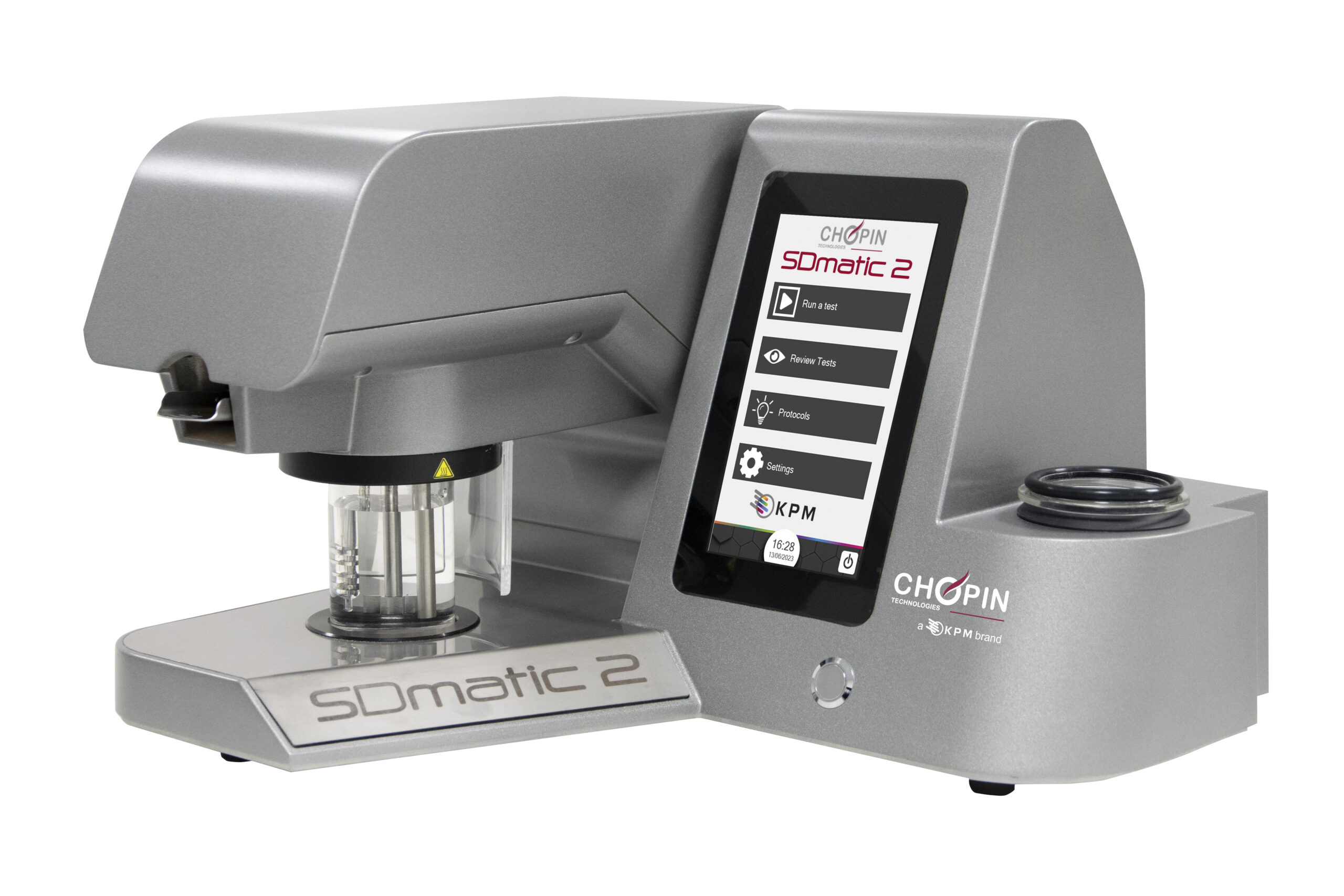
SDmatic
Also known as as starch damage measurement/analysis
What is SDmatic?
The SDmatic is a tool for measuring the content of damaged starch in flour (refined or whole grain) or starch samples.
It is a key test for bakeries interested in controlling the level of starch damage and its impact on baking performance indicators such as water absorption and yeast activity.
- Define the end use/application of wheat flours
- Optimize flour blends and streams at the mill
- Predict the activity of starch-degrading enzymes during breadmaking
- Evaluate the conformity of incoming flour at the bakery
- Adjust water absorption and mixing time to obtain optimum dough properties
- Optimize crust color (browning)
- Evaluate and predict dough machining issues during production
- Adjust milling settings and procedures to comply with quality specifications
- Match quality of flour with type of bakery product
Origin
The SDmatic is based on the work of Medcalf and Gilles (1965).1 Chopin Technologies is currently offering the SDmatic machine as a tool for quality control analysis of cereals, flour and their products. It is a good alternative to the traditional enzymatic methods and is far simpler to operate.
How does it work?
The SDmatic automatically measures the starch damage of a 1-g sample within 10 minutes, based on the ability of starch to bind I2/KI (iodine or potassium iodide).
It uses an amperometric probe to measure the amount and kinetics of iodine absorption by starch granules in a diluted starch-water solution. How fast and how much iodine is absorbed depends on how damaged the starch granules are. Damaged granules absorb iodine at a faster rate than undamaged ones.2
According to AACC International Official Method 76–33.01 (Damaged Starch—Amperometric Method using the SDmatic), the SDmatic test consists of the following steps:3
- Flour moisture and protein content should be determined prior to the test. Results are expressed on a 14% moisture basis.
- Glass reaction vessels and plastic sample holders should be clean and dry.
- Keep flour sample in a sealed container to avoid moisture exchange.
- Weigh 3.0 g of boric acid powder (or 1.5 g of citric acid powder) and 3.0 g of potassium iodide (KI) powder.
- Introduce boric acid and potassium iodide powder into the SDmatic glass reaction vessel.
- Add 120 mL of distilled water and 1 drop of 0.1N sodium thiosulfate solution.
- Weigh 1.0 g of flour or starch sample directly into the SDmatic sample holder.
- Place the glass reaction vessel with the chemical reagents and water into the SDmatic measuring cavity.
- Lower the head of the device, and start the test.
- Enter the exact weight of flour used.
- Introduce the plastic sample holder with the flour into the SDmatic vibratory feeder.
- SDmatic system automatically starts the flour addition at the proper moment when reaction conditions (i.e. temperature and iodine concentration based on electric current) are correct.
- Test takes 6–7 min.
- Results are given in an iodine absorption index percentage (AI%). Record the AI%, UCD and starch damage values on screen.
- An indication of the speed of iodine absorption in seconds is reported as “Vabs.”
- Press the ‘‘starch damage’’ line to see a second screen with the result for Vabs. Record Vabs value as well.
Application
Starch granules that have been mechanically damaged absorb much more water and are more susceptible to degradation by starch-degrading enzymes than undamaged starch. The harder the wheat kernel, the more intense the milling and the higher the amount of damaged starch.4,5
In case the SDmatic test shows high levels of damaged starch, the baker will likely expect the flour to:
- Require longer mixing times to obtain desired dough properties
- Obtain higher yields per dough piece (more water can be put into the dough)
- Be compensated by reducing the levels of added enzymes or dough conditioners
- Have higher yeast activity (gassing power)
- Have faster proofing times / higher fermentation rates
- Produce a slacker dough
- Render baked products with darker crust color
- Produce baked products with greater volume
- Cause a more open cell structure in the baked product
References
- Medcalf, D.G., and Gilles, K.A. “Determination of starch damage by rate of iodine absorption.” Cereal Chemistry, AACC International, 1965, 42:546–557.
- Dubat, A. “Collaborative study concerned with measuring damaged starch using an amperometric method.” Cereal Foods World, AACC International, 2007, 52:319–323.
- AACC International. Approved Methods of Analysis, 11th Ed. Method 76–33.01. Damaged Starch—Amperometric Method by SDmatic. First approval October 10, 2007. Cereals & Grains Association, St. Paul, MN, U.S.A.
- Finnie, S., and Atwell, W.A. “Wheat and Flour Testing.” Wheat Flour, 2nd edition, AACC International, Inc., 2016, pp. 75–76.
- Carson, G.R., and Edwards, N.M. “Criteria of Wheat and Flour quality.” Wheat Chemistry and Technology, 4th edition, AACC International, Inc., 2009, pp. 97–114.

